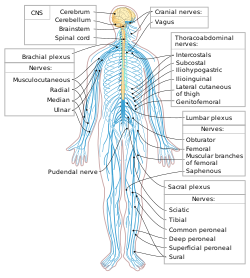
Back Rugmurg Afrikaans Rückenmark ALS Miollo espinal AN نخاع شوكي Arabic ܚܒܠܐ ܟܘܒܝܐ ARC Migollu espinal AST Onurğa beyni Azerbaijani اونورغا بئینی AZB Арҡа мейеһе Bashkir Спінны мозг Byelorussian
| Spinal cord | |
|---|---|
 The spinal cord (in yellow) connects the brain to nerves throughout the body. | |
| Details | |
| Part of | Central nervous system |
| Artery | Spinal artery |
| Vein | Spinal vein |
| Identifiers | |
| Latin | medulla spinalis |
| MeSH | D013116 |
| NeuroNames | 22 |
| TA98 | A14.1.02.001 |
| TA2 | 6049 |
| FMA | 7647 |
| Anatomical terminology | |
The spinal cord is a long, thin, tubular structure made up of nervous tissue that extends from the medulla oblongata in the brainstem to the lumbar region of the vertebral column (backbone) of vertebrate animals. The center of the spinal cord is hollow and contains a structure called the central canal, which contains cerebrospinal fluid. The spinal cord is also covered by meninges and enclosed by the neural arches. Together, the brain and spinal cord make up the central nervous system.
In humans, the spinal cord is a continuation of the brainstem and anatomically begins at the occipital bone, passing out of the foramen magnum and then enters the spinal canal at the beginning of the cervical vertebrae. The spinal cord extends down to between the first and second lumbar vertebrae, where it tapers to become the caudal equina. The enclosing bony vertebral column protects the relatively shorter spinal cord. It is around 45 cm (18 in) long in adult men and around 43 cm (17 in) long in adult women. The diameter of the spinal cord ranges from 13 mm (1⁄2 in) in the cervical and lumbar regions to 6.4 mm (1⁄4 in) in the thoracic area.
The spinal cord functions primarily in the transmission of nerve signals from the motor cortex to the body, and from the afferent fibers of the sensory neurons to the sensory cortex. It is also a center for coordinating many reflexes and contains reflex arcs that can independently control reflexes.[1] It is also the location of groups of spinal interneurons that make up the neural circuits known as central pattern generators. These circuits are responsible for controlling motor instructions for rhythmic movements such as walking.[2]
- ^ Maton, Anthea; et al. (1993). Human biology and health (1st ed.). Englewood Cliffs, N.J.: Prentice Hall. pp. 132–144. ISBN 978-0-13-981176-0.
- ^ Guertin, PA (2012). "Central pattern generator for locomotion: anatomical, physiological, and pathophysiological considerations". Frontiers in Neurology. 3: 183. doi:10.3389/fneur.2012.00183. PMC 3567435. PMID 23403923.
© MMXXIII Rich X Search. We shall prevail. All rights reserved. Rich X Search